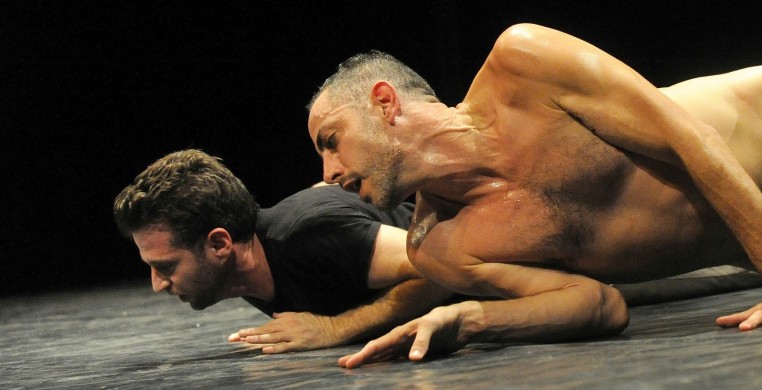The wide-open MCA stage became a blank canvas for the broad brush strokes of Joanna Ronsenthal Read’s “Stripped,” (premiere), and Niv Sheinfeld and Oren Laor’s “Vanishing Point,” (premiere) and “Two Room Apartment” (2012) this past weekend.
Rosenthal Read’s “Stripped,” created with SPDW’s cast of two women and three men, begins with one man dragging another across the stage and lifting his rag doll body, accompanied by the lament of a sonorous cello. Coloring the interchange of the two women in chairs side by side downstage, the gesture of a hand to the cheek, breast, or mouth, the hand’s slow extension into space as if to touch air, and bodies gently resting on each other momentarily, suggested the impermanence of connection and the isolation of the individual. Lyrical flow with modern permutations of sautés, jetés, and pas de chats painted easy energy across space, while stillness and a deliberateness of gesture--the turning of a head, the flexing of a shoulder, a hand to the neck--punctuated the poignancy of the dancers’ aloneness. Fleeting intersecting of bodies in flight, gorgeous lifts, and rhythmically intricate interactions distinguished choreographic structure. As electronic interference overwhelmed the cello, lyricism gave way to a more activated space. Abrupt, broken movement rhythms sent dancers careening off each other’s angles in a counterpoint of patterns, slow-motion against frenetic vibrating, beginning with one, then two, until the vibrating overtook the entire group. Culminating in a circle, one by one, the dancers extended a hand, reaching out to each other to strong emotional impact.
Making a right-angle turn into the physical theatre of Sheinfeld and Laor’s “Vanishing Point,” four SPDW dancers blast toward the audience with raucous abandon, singing to Janis Joplin’s “Look Down On Me!” Their explosive, let-loose energy and riff on pop dance clichés is all ingenuous fun, and funny, as they knock their own socks off over and over again until the music runs out and stops them dead in their tracks. Silence. They are utterly lost. “Can you play it again?” one woman asks the sound engineer. Instantaneously with the music, like blow-up toys, they re-inflate their animation in an exact replication of what came before, the superficial structure of the pop idiom fueling their collective personas. A group hug spins into a self-congratulatory mood and even more “inspired” spectacle, each dancer grandstanding in turn, including fouetté turns in sneakers. Again, music runs out, recorded applause fades, and once more the question, “Can you play it again?” This time, the answer is “no.” They try the same movement in silence, but it devolves into elbow jabs and agitated walking, falls to the floor, and a sequence of floor drills that don’t quite add up to any real structural consequence. In the end, the piece that began with such clarity feels like it doesn’t quite know where to go, and so, they sing, “It looks like everybody in this whole round world is down on me,” reprising the last three words of the opening. As dance, the end of the piece falls short on movement invention and narrative intention. As performance art, perhaps anything goes. Whatever the idiom, it was a limp substitute for the structural substance the end of this promising piece demands.
Sheinfeld and Laor’s adaptation of Liat Dror and Nir Ben Gal’s 1987 “Two Room Apartment” crosses the border into full-blown performance art, opening the way for the audience, which is now seated in close quarters along three sides of the stage, to suspend judgment as well as preconceptions. Its two creators enter as pedestrians and begin delineating their two-room apartment with white gaffer’s tape. Once in place, each occupying his separate room, the two repeat a dressing ritual comprised of abstracted gestures performed in unison and progressing gradually forward, then repeating in the opposite direction. This goes on for some time, extreme repetition making its point. Again and again, they walk the perimeters of their separate rooms, accelerating to the music of a conventional march with drum and recorder. Loose-arm forays into full abstract movement gradually break up the regimentation of walking and they cross over into each other’s space, interacting with lifts and spins. The movement is simple, in service of the relationship. Sheinfeld summarily removes all of his clothing, then clings naked to Laor like a baby. Over and over again, Sheinfeld clings and Laor drops him, the repetition creating emotional tension that rips open to high-stakes relationship drama, but not for long. Ever-shifting in mood and direction, the 50-minute piece somehow always commands attention and interest. A clownish Sheinfeld, in a stone-in- the-shoe sequence, brought laughter and pathos reminiscent of “Godot,” where life happens while you wait.

